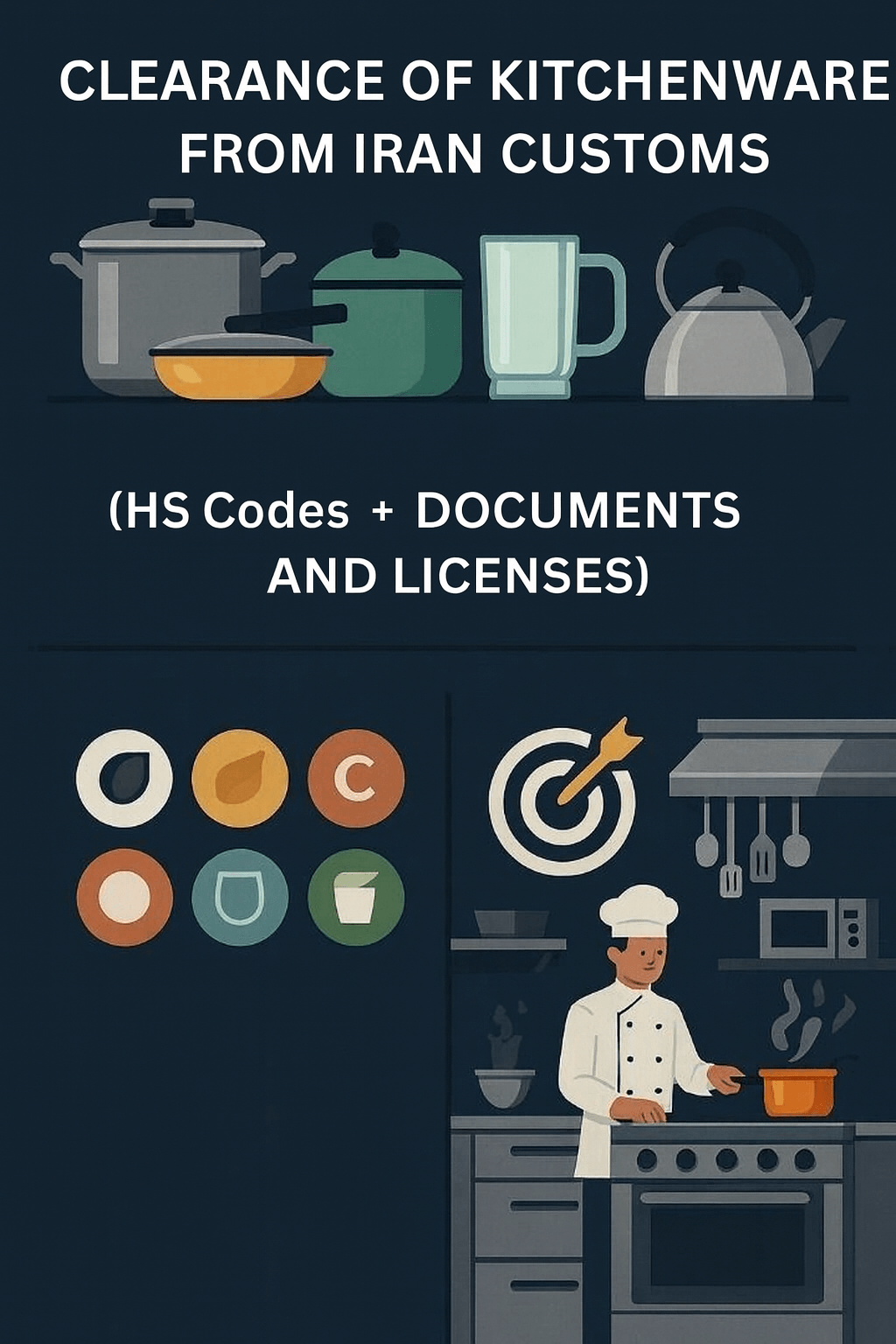Specialized Clearance of Kitchenware from Iran Customs (HS Codes + Documents & Permits)

For estimating the time and cost of kitchenware clearance, contact the experts at Saba Tarkhis.
Instant free consultation1) Detailed Description of the Goods and Their Importance in the Domestic Market
Kitchenware is one of the essential supplies used in homes, restaurants, hotels, and cafés, and demand for high-quality, modern products in Iran is constantly rising. The diversity of materials (steel, aluminum, copper, porcelain, ceramic, glass, and plastic), design, and usage (cooking, serving, storage) means the selection of tariff codes, documents, and permits must be done with greater care. Part of imports is also intended for industrial/professional kitchens, which have stricter standard and sanitary requirements.
2) Types of Kitchenware with HS Codes and Uses
| Product Group | Sample Item / Use | HS Code |
|---|---|---|
| Stainless steel cookware | Pots, pans, durable cookware | 732393 |
| Aluminum cookware | Lightweight, high heat transfer, fast cooking | 761510 |
| Copper cookware | Excellent thermal conductivity; traditional/professional kitchens | 741810 |
| Porcelain & ceramic tableware | Serving in homes/hotels/restaurants | 691110 (porcelain), 691200 (ceramic) |
| Heat-resistant glassware | Cooking/serving with a clear appearance | 701337 |
| Plastic ware | Everyday use, lightweight, economical | 392410 |
| Enamelled metal ware | Enamel coating; heat/rust resistance | 732392 |
| Metal kettles & teapots | Stainless/heat-resistant metal; homes and cafés | 732111 |
| Teflon / non-stick cookware | Non-stick, easy to wash; usually aluminum base | 761510 (aluminum with Teflon coating) |
Final code selection depends on exact material, coating, use, whether set/single, and packaging.
3) Key Points in Clearance and Legal/Sanitary Requirements
- To clear kitchenware from customs, cooperation with an experienced customs broker familiar with customs laws and regulations is essential. This cooperation can prevent many potential issues and delays and significantly speed up the clearance process. Specialized customs brokers can handle the following:
Obtaining sanitary and safety permits/certificates: Importing kitchenware requires obtaining sanitary and standard permits from relevant authorities. International certificates confirming product quality and safety are also necessary.
Reviewing and selecting the proper tariff code: Choosing the correct HS Code is one of the most important stages in the clearance process. Correct selection reduces customs costs and prevents possible delays.
Preparing and filing the required documents: Commercial documents such as invoices, packing lists, and standard certificates must be properly prepared and filed. Registering information in the Comprehensive Trade System is also among the essential steps.
Paying customs duties and taxes: Kitchenware is subject to customs duties and taxes. Timely payment of these costs and providing the related documents is highly important.
Expediting the clearance process: Using professional brokerage services can significantly facilitate clearance and prevent delays and extra costs.
4) Selected Customs Tariff Codes (HS Codes)
Stainless steel cookware
HS Code: 732393
These include pots, pans, and other cookware made of stainless steel. Due to high corrosion resistance and long service life, this type is very popular.
Aluminum cookware
HS Code: 761510
Aluminum-made cookware is a suitable choice for fast cooking because it is lightweight and has high thermal conductivity.
Copper cookware
HS Code: 741810
Copper utensils are known for their elegant look and excellent heat conductivity. They are mostly used in traditional and professional kitchens and play an important role in precise cooking.
Porcelain & ceramic tableware
HS Code: 691110 (porcelain) and 691200 (ceramic)
Porcelain and ceramic tableware are in high demand due to their beauty and wide use in serving food, especially in restaurants and hotels.
Glassware
HS Code: 701337
This category includes various heat-resistant glass containers used for cooking and serving food, distinguished by their clear and attractive appearance.
Plastic ware
HS Code: 392410
Plastic containers are suitable for everyday use in homes and informal places due to their light weight and low production cost.
Enamelled ware
HS Code: 732392
These metal containers with enamel coating are a suitable option for cooking and storing food thanks to their high resistance to heat and corrosion.
Metal kettles and teapots
HS Code: 732111
Metal kettles and teapots—especially those made of stainless steel—are widely used in kitchens and cafés because they withstand high heat.
Non-stick / Teflon cookware
HS Code: 761510 (aluminum cookware with Teflon coating)
5) Special Conditions for Import and Export of Kitchenware
6) Iran’s Import and Export Volumes
Imports of kitchenware into Iran have increased especially in recent years. Statistics show that a considerable volume is imported from China and Turkey, such that these two countries alone supply about 60 percent of Iran’s kitchenware market needs. Other countries such as Italy and India also have a share, particularly for higher-quality, modern products.
On the other hand, Iran’s kitchenware exports are also growing. Although the export volume is less than imports, by focusing on neighboring markets, Iran has achieved considerable growth in exporting lightweight plastic and metal ware to countries such as Iraq, Afghanistan, and other Middle Eastern markets. Iran’s exports are mostly based on low-cost goods with affordable production, which is attractive for developing countries.
7) Global Kitchenware Market
The global kitchenware market has a high turnover and forecasts indicate it will continue to grow. According to recent reports, the total value of global kitchenware trade is estimated at about $85 billion, and is still increasing due to strong demand for modern products—especially in both developing and developed countries.
China is the largest exporter of kitchenware worldwide and accounts for more than 40 percent of global exports. After China, Turkey, Italy, India, and Germany are also major exporters of kitchenware. Due to advanced production technologies and high product quality, these countries have strong demand in international markets.
Conversely, the largest importers of kitchenware globally include the United States, European Union countries (such as Germany, France, and the United Kingdom), and Japan. Because of large populations and high consumer demand for quality products, these countries import significant volumes of kitchenware.
8) Major Global Exporters and Importers
Key exporters
- China (over 40% of global exports), followed by Turkey, Italy, India, and Germany.
Major importers
- The United States, the European Union (Germany/France/UK), and Japan, with strong demand for high-quality products.
9) Required Documents for Kitchenware Clearance
1. Commercial Invoice
The commercial invoice is one of the most important documents and includes details related to the purchase and sale of the goods. It must include the price, quantity, product type, terms of sale, and the details of the seller and buyer. This document is the basis for calculating customs duties and charges.
2. Packing List
The packing list includes precise details of the contents of each package, such as quantity, type of packaging, the weight of each package, and even the arrangement of products inside the packages. It is very important for quick identification in customs and for transportation.
3. Certificate of Origin
The certificate of origin indicates the country where the goods were produced. It is usually issued by the chamber of commerce of the exporting country and is necessary to determine the customs tariff and to benefit from tariff preferences based on trade agreements between countries.
4. Bill of Lading or Airway Bill
The bill of lading is a document showing that the goods have been shipped by the carrier to the buyer. It includes information such as shipment details, consignor, consignee, and the final destination. It is required both for transport and for customs clearance.
5. Health and Safety Certificates
Because kitchenware comes into direct contact with food, sanitary permits are required. These permits confirm that the goods comply with the country’s sanitary standards. In Iran, the National Standards Organization and the Ministry of Health are responsible for issuing these permits.
6. Inspection Certificate
Some goods require pre-shipment inspection. The inspection certificate is issued by reputable companies and shows that the goods conform to the order in terms of quality and quantity. These inspections are usually performed by the buyer or by recognized inspection bodies.
7. Order Registration in the Comprehensive Trade System
Registering the import order in the Comprehensive Trade System is one of the main requirements for importing goods into Iran. This system allows customs and other relevant organizations to view and assess order details. Without order registration, goods cannot be cleared.
8. Import License (Business Card)
The import license (business card) allows companies and individuals to legally import and export goods. It is issued by the chamber of commerce and is required for any international trade.
9. Customs Declaration
The customs declaration includes precise information about the goods, their value, weight, and type of packaging. It must be fully and accurately prepared and submitted to customs. Any error can lead to delays or even fines.
10. Special Import Permits (if required)
Some types of kitchenware may require special permits. For example, non-stick cookware or items made from certain chemical materials may require permits from other bodies such as the Environmental Organization. These permits vary based on product type and import regulations.
11. Proof of Payment of Duties and Taxes
Importers must pay all duties and taxes related to the import and provide receipts to customs. This includes customs duties, value-added tax (VAT), and other related costs.
Having these documents is essential for kitchenware clearance and ensures the process proceeds faster and without issues. Working with a professional customs broker such as Saba Brokerage helps ensure all documents are correctly prepared and submitted on time so that clearance is completed with minimal delay and cost.
Key Tips and Practical Recommendations
- For multi-material sets (e.g., steel + glass), code items separately or determine the dominant line.
- For non-stick cookware, keep coating documentation (PFOA/PFOS-free and migration tests) ready.
- For enamelled/porcelain goods, heavy metals testing (lead/cadmium) is critical.
- If claiming “heat resistant,” attach the manufacturer’s certificate and the relevant standard.

Frequently Asked Questions
What permits are required for non-stick cookware?
Sanitary/standard permits, non-stick coating documentation, and migration test results; sampling may be conducted at customs.
What are the HS codes for steel/aluminum/porcelain items?
Steel: 732393, aluminum/non-stick: 761510, porcelain: 691110; the final choice depends on material/use/packaging.
How can we reduce the risk of clearance delays?
Accurate HS, complete documentation, obtaining sanitary permits before entry, prompt responses to inquiries, and using customs e-services.
Should multi-piece sets be declared together?
Depending on the composition/material/use: either the dominant heading is determined for the set, or items are declared and coded separately.
Specialized Kitchenware Clearance Services by Saba Brokerage
- With years of experience in customs clearance and full familiarity with customs regulations, this brokerage provides special services for kitchenware importers. These services are performed by a specialized team well-versed in import laws and procedures, completing the clearance process accurately and quickly.
Specialized consulting: Providing guidance throughout all stages—from selecting the correct tariff code to obtaining the necessary permits.
Obtaining permits: All sanitary and standard permits are obtained on behalf of clients to ensure full compliance with regulations.
Document preparation: Preparing and completing all required documents, including invoices, certificates, and other commercial papers, with precision.
Faster clearance: Thanks to the team’s extensive experience, goods are cleared with minimal delays and reduced extra costs.
Full follow-up: All stages—from initial registration to final clearance and delivery—are followed closely to ensure no issues arise during the process.
By leveraging these professional and comprehensive services, kitchenware importers can enjoy a fast and worry-free clearance experience.
Contact us for more information and specialized consultation.
.png)
